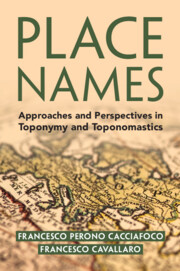Book contents
- Place Names
- Place Names
- Copyright page
- Contents
- Figures
- Tables
- Preface
- Acknowledgements
- 1 Introduction
- 2 Language Change
- 3 Historical Toponomastics
- 4 Toponymy and the Historical-Linguistic Reconstruction of Proto-Languages
- 5 Diachronic Toponymy
- 6 Landscape and Toponymy
- 7 Historical Toponomastics and Historical Geography
- 8 Synchronic Toponymy
- 9 Place Names and Society
- 10 Toponymy and Cartography
- Glossary
- References
- Index
7 - Historical Toponomastics and Historical Geography
Published online by Cambridge University Press: 02 March 2023
- Place Names
- Place Names
- Copyright page
- Contents
- Figures
- Tables
- Preface
- Acknowledgements
- 1 Introduction
- 2 Language Change
- 3 Historical Toponomastics
- 4 Toponymy and the Historical-Linguistic Reconstruction of Proto-Languages
- 5 Diachronic Toponymy
- 6 Landscape and Toponymy
- 7 Historical Toponomastics and Historical Geography
- 8 Synchronic Toponymy
- 9 Place Names and Society
- 10 Toponymy and Cartography
- Glossary
- References
- Index
Summary
Historical geography is one of the disciplines associated with toponymy and historical toponomastics. It aims to investigate the settlements and land uses of a place with evidence from archival sources and can help to analyse the remote origins of place names. This is evident in the example of Bistagno, a village located in Piedmont, northwest Italy. A number of scholars have used historical-geographic methods and sources to account for its name, with varying degrees of success. Methods and sources from historical geography can also be used in more contemporary contexts. For example, another case study shows how written records and newspapers were utilised to study the many toponyms renamed after Romania turned Communist – with the aim of celebrating the Communist ideology, figures, and worldview. This was followed by an extensive renaming in Romania’s post-Communist/post-Socialist era, when the new leaders removed links to Communism. In the case study of Singapore, the authors trace the names and naming processes connected with three toponyms in the relatively young nation, by using maps, archival documents, and books. The new field of study, historical geographic information systems, brings a new tool to the historical analysis of environments and geographic areas.
Keywords
- Type
- Chapter
- Information
- Place NamesApproaches and Perspectives in Toponymy and Toponomastics, pp. 158 - 189Publisher: Cambridge University PressPrint publication year: 2023

